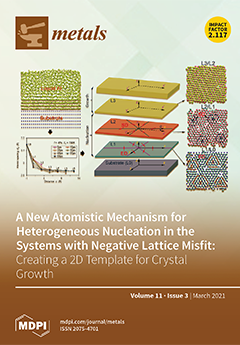The study was designed to investigate the synergic effect of Ti and Sn in the active metal brazing of Al
2O
3 ceramic to copper brazed, using the multicomponent Ag-Cu-Zr filler alloy. Numerous fine and hexagonal-shaped rod-like ternary intermetallic (Zr, Ti)
5
[...] Read more.
The study was designed to investigate the synergic effect of Ti and Sn in the active metal brazing of Al
2O
3 ceramic to copper brazed, using the multicomponent Ag-Cu-Zr filler alloy. Numerous fine and hexagonal-shaped rod-like ternary intermetallic (Zr, Ti)
5Sn
3 phase (L/D = 5.1 ± 0.8, measured in microns) were found dispersed in the Ag-Cu matrix of Ag-18Cu-6Sn-3Zr-1Ti alloy, along with the ternary CuZrSn intermetallic phases. An approximate 15° reduction in contact angle and 3.1 °C reduction in melting point are observed upon the incorporation of Ti and Sn in Ag-18Cu-3Zr filler. Interestingly, the interface microstructure of Al
2O
3/Cu joints brazed by using Ag-18Cu-6Sn-3Zr-1Ti filler shows a double reaction layer: a discontinuous Ti-rich layer consisting of (Cu, Al)
3(Ti, Zr)
3O, TiO, and in-situ Cu-(Ti, Zr) precipitates on the Al
2O
3 side and continuous Zr-rich layer consisting of ZrO
2 on the filler side. The shear strength achieved in Al
2O
3/Cu joints brazed with Ag-18Cu-6Sn-3Zr-1Ti filler is 31% higher, compared to the joints brazed with Ag-18Cu-6Sn-3Zr filler. Failure analysis reveals a composite fracture mode indicating a strong interface bonding in Al
2O
3/Ag-18Cu-6Sn-3Zr-1Ti filler/Cu joints. The findings will be helpful towards the development of high entropy brazing fillers in the future.
Full article





